Conroe Buying Guide: Feeding the Monster
by Gary Key & Wesley Fink on July 19, 2006 6:20 AM EST- Posted in
- Motherboards
Standard Gaming Performance
We tested with a small group of games due to time constraints, but we picked games based on a variety of game engines to give a quick indication of the boards' performance. Additional testing will be done in our full board reviews but for this roundup we are using Serious Sam 2, Half Life 2: Lost Coast, F.E.A.R, Quake 4, and Battlefield 2. All boards were tested with the EVGA 7900GTX using NVIDIA 91.31 WHQL drivers. The Intel 975X boards were also tested with a single ATI X1900XTX card with the Catalyst 6.6 driver.
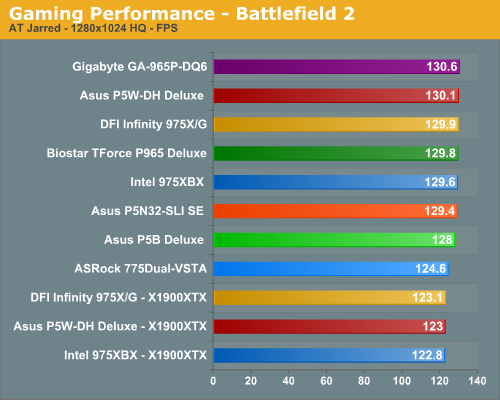
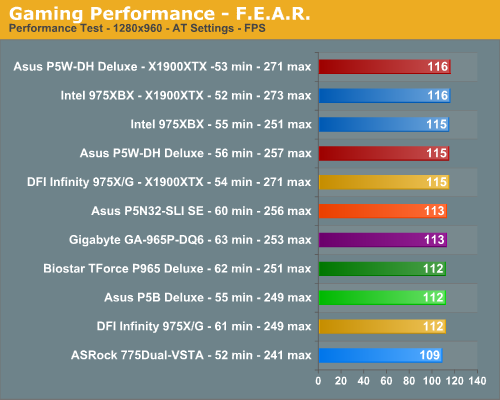
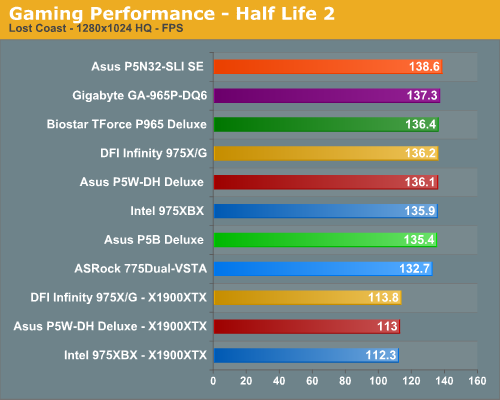
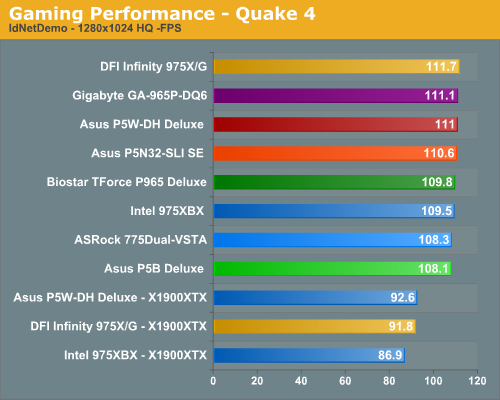
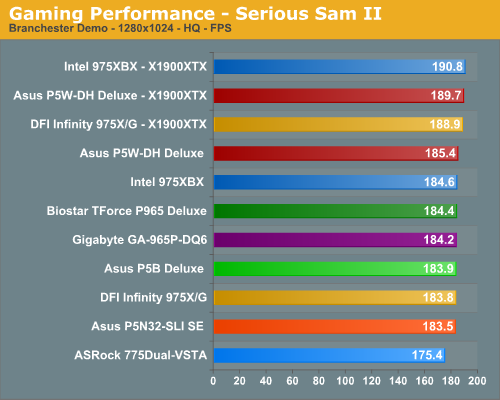
The two most performance oriented boards in our roundup are the ASUS P5W-DH and Gigabyte GA-965P-DQ6 boards, and they complete our gaming benchmarks with scores at or near the top of each game category. The most consistent board in the roundup is the Biostar TForce P965 Deluxe that stayed the course throughout testing by remaining in the middle sector of the group. Although the Biostar board did not finish first, it also did not have swings where it was at the top of one benchmark and near the bottom on another one. The ASRock board finished last among the 7900GTX boards four times and second to last on the Quake 4 test where it had its best showing. Overall, the scores generated by this group of boards are so close that you would be hard pressed to actually see or feel the difference in real game play.
The ATI X1900XTX cards finished significantly behind the NVIDIA cards in Half Life 2: Lost Coast where they generally score even or ahead of NVIDIA depending upon game settings. While their performance in the DOOM 3 engine games are normally several percentage points behind the NVIDIA based cards until recently, the difference in our Quake 4 test is also perplexing with the current 6.6 driver release. We ran our ATI X1900XTX in the ASUS P5N32-SLI board and the percentage differences between the GPUs were the same that we see on the AMD S939 or AM2 platforms. It appears to us at this time there is an ATI driver bug with the current Intel chipsets and Core 2 Duo, or perhaps a lack of optimization.
We tested with a small group of games due to time constraints, but we picked games based on a variety of game engines to give a quick indication of the boards' performance. Additional testing will be done in our full board reviews but for this roundup we are using Serious Sam 2, Half Life 2: Lost Coast, F.E.A.R, Quake 4, and Battlefield 2. All boards were tested with the EVGA 7900GTX using NVIDIA 91.31 WHQL drivers. The Intel 975X boards were also tested with a single ATI X1900XTX card with the Catalyst 6.6 driver.





The two most performance oriented boards in our roundup are the ASUS P5W-DH and Gigabyte GA-965P-DQ6 boards, and they complete our gaming benchmarks with scores at or near the top of each game category. The most consistent board in the roundup is the Biostar TForce P965 Deluxe that stayed the course throughout testing by remaining in the middle sector of the group. Although the Biostar board did not finish first, it also did not have swings where it was at the top of one benchmark and near the bottom on another one. The ASRock board finished last among the 7900GTX boards four times and second to last on the Quake 4 test where it had its best showing. Overall, the scores generated by this group of boards are so close that you would be hard pressed to actually see or feel the difference in real game play.
The ATI X1900XTX cards finished significantly behind the NVIDIA cards in Half Life 2: Lost Coast where they generally score even or ahead of NVIDIA depending upon game settings. While their performance in the DOOM 3 engine games are normally several percentage points behind the NVIDIA based cards until recently, the difference in our Quake 4 test is also perplexing with the current 6.6 driver release. We ran our ATI X1900XTX in the ASUS P5N32-SLI board and the percentage differences between the GPUs were the same that we see on the AMD S939 or AM2 platforms. It appears to us at this time there is an ATI driver bug with the current Intel chipsets and Core 2 Duo, or perhaps a lack of optimization.










123 Comments
View All Comments
Gary Key - Wednesday, July 19, 2006 - link
We are looking forward to the value SLI boards in early August. Prices will range on average from $95 to $120. As soon as we can post a review up on these boards, it will be done. :)EODetroit - Wednesday, July 19, 2006 - link
Can Anandtech max out the memory and make sure these systems are stable in 64 bit Windows OS'? I'd really like to make sure that there's no time bombs if I buy 8GB of ram that will force me to RMA a lot of stuff. If you don't have 2GB sticks, at least test with 4x1GB. The motherboards advertise that they support 8GB, but no one ever seems to check them on it. If Anandtech could do that, it would be a great help.Thanks!
Genx87 - Wednesday, July 19, 2006 - link
Not bad for an older chipset to win the SLI benchmarks.I am curious what the new chipset can do!
supremelaw - Wednesday, July 19, 2006 - link
Dear Gary and Wesley,I'm thinking back to about 8 months ago,
when we first started assembling our
ASUS P5WD2 Premium motherboard
(which has recently become our primary
production machine).
We offered our assistance at the ASUS
User Forum, because a LOT of users
were stumbling over the IT8211F IDE
controller, which requires a device driver
to be extracted from the Support CD.
I fear that P965 motherboards are headed
for the same serious problems, particularly
if motherboards add an on-board IDE
controller that is NOT "native" e.g. JMicron.
Here's the scenario: a less-than-expert
user sees a PATA IDE port, and thinks
he can use (or recycle) a PATA optical
drive to run Windows Setup. And, he's
probably read (or heard) the stories about
SATA optical drives that just don't work
with Windows Setup.
Is this user headed for major problems?
I think so.
And here's why ...
If the BIOS has not been modified to
support native PATA / IDE optical devices,
a Catch-22 results: you need the device
driver from the Support CD, but you can't
read the Support CD without the device
driver -- not if the optical device is wired
to that on-board IDE controller.
If you want confirmation of this problem,
check out the ASUS User Forum for the
P5WD2 Premium, particularly the numerous
complaints Users were posting about the
ITE IT8211F on-board IDE controller.
To make this problem even more exasperating,
the User Manual failed to mention that the
F6 sequence will load the ITE driver during
Windows Setup, BUT one can STILL not
run Windows Setup from an optical drive
wired to that ITE controller. The device driver
can be added AFTER Windows XP is
successfully installed.
Fortunately, the P5WD2 Premium has a
BLUE native IDE port as well, and we
avoided all of these problems by running
Windows Setup from a PATA optical drive
wired to that BLUE native IDE port.
Thanks for all the great reviews!
Sincerely yours,
/s/ Paul Andrew Mitchell
Webmaster, Supreme Law Library
http://www.supremelaw.org/">http://www.supremelaw.org/
Gary Key - Wednesday, July 19, 2006 - link
Hi Paul,The scenario you listed is a very real possibility and as you have noted has existed in past boards. In fact, I was on the phone with Wes when our first P965 was fired up and the Optical Drive was not recognized. Of course, I had a few choice words to say about the situation. The only way to load the new OS image and Driver CD was through the Optical drive and that was not going to happen in this case. I ended up loading a new image on a drive in another system, installing the inf and network drivers in a folder, and then moving this drive to the new machine. The issue was a very early bios that did not support the hooks from the external IDE chipset into the ICH8. We received an updated bios a few days later and all was well from that point forward.
Since Intel has basically left a "lane" open in the ICH8 to support IDE (much in the same way as the LAN controller logic, being real simple here to keep it short), then the only issue is to ensure the bios has support for the IDE link. We have not seen this issue at all in the latest boards that we have received and have been told it will not occur in shipping boards. While most suppliers are going with the JMicron solution, Biostar included the VIA VT6410 that turned out to offer excellent performance in our upcoming storage tests. I hope this helps and thank you for your comments today.
:)
Andy4504 - Wednesday, July 19, 2006 - link
I was most surprized by the poor BadAxe (X975XBX) Overclocking. Because the memory controller isn't directly tied to the FSB speeds, the fact that you cannot incrase the memory voltage without hardware modification should make little / no difference in CPU overclocking.I personally own a X975XBX with an 805D. I've found that the best overclocking isn't done by selecting +30% OR + any percent for that matter, but rather choosing the higher bus speed, then selecting an underclock from that higher speed.
With full access to the memory multiplier range, most any ratio could be set.
Wesley Fink - Wednesday, July 19, 2006 - link
Conroe runs at 1066 FSB speed. 1333 support has been in and out of the different BIOS revisions. So with Conroe you can select no higher bus speed at worst, or a modest 1333 at best. 805D runs at 533 (166 quad) so you have differnt options. It really isn't possible to select higher bus speeds and clock down with Conroe on the BadAxe.Paladin165 - Wednesday, July 19, 2006 - link
In the review you mention that the 7600GT would work with the cheap ASrock board, I was thinking about going with this setup (if another ultra-cheap board doesn't come out soon). I was wondering, how much impact would the 4x PCIex speed have on the 7600GT? Are there any situations where it would choke off performance? Does it provide enough power?This cheap board seems like a good buy because new motherboards are going to be coming out so rapidly over the next six months it doesn't make sense to drop $250 on a bleeding-edge board.
Gary Key - Thursday, July 20, 2006 - link
The 7600GT works fine. I am trying to procure a 7600GS PCIe and AGP cards to directly compare the video performance on the board. Hopefully, I will have both cards before the full review goes up. We also have two other ASRock boards that are under $75 arriving shortly. I think the performance with the 7600GT will be fine unless you like to play Oblivion and even with the PCIe x4 interface you will not notice a real difference with this card.Paladin165 - Thursday, July 20, 2006 - link
"I think the performance with the 7600GT will be fine unless you like to play Oblivion"!!!
Oblivion is exactly what I want to play! What is it about this setup that hurts Oblivion performance?